Manmade Barriers Threaten Wildlife Migration
Manmade barriers to migration jeopardize one of the great wonders of the natural world. Migration is a critical part of many species’ life cycles. But barriers such as fences, roads, dams, and windmills can have a tremendous impact on wildlife populations and their ability to migrate.
Migration has occupied human thought for millennia. We have learned much about migration since Aristotle posited that the summer’s Redstarts transformed into Robins for the winter. Today, however, we are learning about the negative impacts human disturbance and development can have on migrating wildlife.
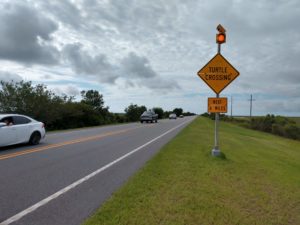
Roads can be significant barriers to wildlife migration. On the causeway to Jekyll Island, Georgia, turtles in search of nesting habitat need to dodge speeding traffic. Photo by Chris Pupke
What is migration?
Migration is the seasonal movement of animals from one region to another. Animals migrate in search of food or breeding habitat. A wide diversity of animals migrate. These include mammals, birds, reptiles, amphibians, fish and even insects.
In the past few months, some insect migrations have been covered in the press including the Painted Lady and dragonflies. The Painted Lady is a butterfly that had a large migration this spring in the west: https://www.nbcnews.com/news/us-news/southern-california-skies-fill-butterflies-thanks-painted-lady-migration-n982551 Dragonflies were recorded on radar this fall while migrating through the Midwest: https://www.cnn.com/2019/09/12/us/dragonfly-weather-radar-scn-trnd/index.html
As for how these creatures migrate, (including some like Monarch butterflies that complete a generational migration!), it is beyond the scope of this blog. Cornell Lab of Ornithological has a good page for birds: https://www.allaboutbirds.org/the-basics-how-why-and-where-of-bird-migration/
In this blog, we will examine some of the man-made barriers to migration that threaten the various animals that rely on migration as a vital part of their life cycle.
Barriers to Migration: By Land
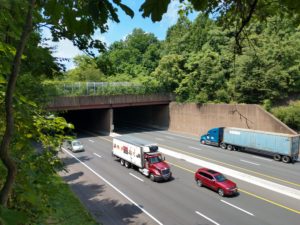
When existing highways split wildlife habitat in two, wildlife crossings can help ameliorate the negative impacts of the highway on wildlife. This wildlife crossing in Union County New Jersey connects two portions of Watchung Reservation (the largest wildlife reservation in the county) split by I-78 just 20 miles west of New York City. Photo by Chris Pupke
Roads and fences are two of the most disruptive barriers to land migration. Both present obstacles that can prove fatal to wildlife. Roads can be a death trap for migrating wildlife as they dart between speeding cars. Fencing for livestock can present an insurmountable obstacle for migrating wildlife.
With regard to roads, the best approach is to stop building them. In the absence of this option, wildlife crossovers can be placed in areas of greatest migratory usage. These crossovers benefit migratory wildlife like elk, mule deer and more. They can also be cost-effective when properly placed by reducing damage to vehicles from animal collisions. One study showed that between 2014 and 2017 animal collisions caused more than $5.4 billion in damages to vehicles.
Fencing on ranches is another significant barrier to migration. When a poorly installed fence is constructed, it can cut off migratory pathways. It can also separate young from their parents. These fences can even become death traps when an animal gets entangled in them.
By simply following a few simple guidelines such as the height of the top and bottom strand of the fence, ranchers can secure their herds and give wildlife access to migratory pathways. You can read more about wildlife-friendly fencing in one of our blogs: https://www.biophiliafoundation.org/wildlife-friendly-fencing/
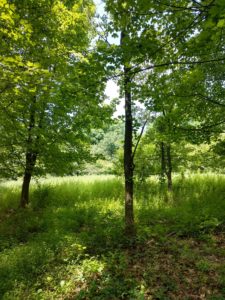
This is the wildlife’s view of the I-78 wildlife overpass at Watchung Reservation. Just a few feet below this pastoral landscape, cars, and trucks roar by at highway speed. Photo by Chris Pupke.
Barriers to Migration: By Sea
Many species of wildlife migrate across oceans, up rivers, and into creeks. One of the most significant threats to aquatic migration is dams. Many species of fish migrate from open waters to headwaters to spawn. Whether placed for water retention or hydroelectric power generation, dams can completely disrupt migratory pathways for fish.
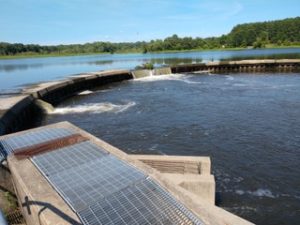
This dam on the Tuckahoe River near Queen Anne, Maryland eliminates miles of fish spawning habitat upstream. Photo by Chris Pupke
Dam removal is by far the most effective way to eliminate the barrier that dams present to migrating fish. The Bloede Dam was recently removed from the Patapsco River near Baltimore. This dam removal reopened roughly 60 miles of fish spawning habitat for fish like shad, herring, and American eel. You can see a video of the planned removal of the Bloede Dam at the Maryland Department of Natural Resources website: https://dnr.maryland.gov/fisheries/Pages/fishpassage/bloede.aspx Note that the fish ladders were deemed to be ineffective in the Bloede Dam situation – only removal of the dam would sufficiently address the migration barrier posed by the dam.
Barriers to Migration: By Air
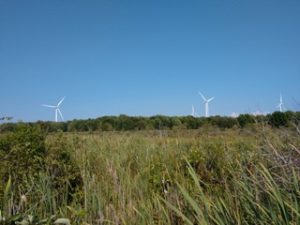
The Wolf Island Windfarm is one of the deadliest windfarms in North America for birds and bats. It is located in Ontario at the eastern end of the Great Lakes. Photo by Chris Pupke
One of the most lethal barriers to migration is windmills. Poorly located windmills can slaughter migrating birds. Too often, windmills are simply placed in a windy location without regard to migratory pathways.
For example, the Wolfe Island Wind Farm is one of the deadliest barriers to avian migration in North America. Wolfe Island is located in southern Ontario near the confluence of Lake Ontario and the St. Lawrence River. The wind farm consists of 86 wind turbines placed on an island at the extreme eastern end of the Great Lakes. Any bird that migrates around Lake Ontario is threatened by the wind farm.
Wolfe Island is considered a globally significant Important Bird Area by Nature Canada. Among the most impacted birds on Wolfe Island are Tree Swallows, Purple Martins, Bobolinks, Barn Swallow, Rough-legged Hawks, and Short-eared Owls. Even three species of bats have been negatively impacted by the poorly located wind farm.
Barriers to Migration: Loss of Habitat
By far the most significant barrier to migration is the destruction of habitat. Whether for development or conversion to agriculture, loss of habitat completely eliminates migration corridors and stopovers for wildlife.
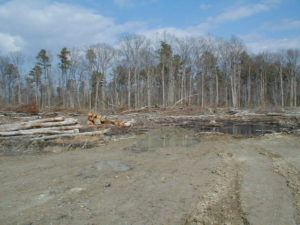
Habitat destruction is one of the greatest threats to migration. This wooded wetland was home to endangered Delmarva fox squirrels and forest-interior dwelling birds at the time of its clearcutting. Photo by Chris Pupke
Princeton University researchers David S. Wilcove and Martin Wikelski note that “(a)round the world, many of the most spectacular migrations have either disappeared due to human activities or are in a steep decline.” But they are also optimistic that this bleak trend can be stopped:
“The challenges –scientific, economic, and social –associated with protecting migratory species are enormous. But so too are the payoffs. We can preserve phenomena that have awed and sustained us since the dawn of humanity. We can protect ecological processes that are integral to many of the planet’s ecosystems. And we can solve scientific puzzles that have baffled natural historians for millennia. If we are successful, it will be because governments and individuals have learned to act proactively and cooperatively to address environmental problems and because we have created an international network of protected areas that is capable of sustaining much of the planet’s natural diversity.” Wilcove, DS; Wikelski, M; Going, Going, Gone: Is Animal Migration Disappearing?. PLoS Biol 6(7): e188.
Biophilia Foundation Helping To Preserve Migration:
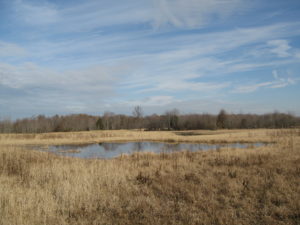
While preservation and restoration of habitat remain our main goal, Biophilia Foundation is also working with our partners to help ensure barriers to migration do not proliferate, while also mitigating the impact of existing migration barriers. Our partners are: restoring wetlands in the Chesapeake region; restoring and protecting jaguar corridors in Southern Arizona and across the border in Sonora, Mexico; conducting research and advocating against an impermeable (for wildlife) border wall; working with states to plan highway overpasses and underpasses for wildlife; and advocating for the Wildlife Conservation Corridors Act.
You can read more about the benefits of restored wetlands in the blog covering the habitat restoration Biophilia conducted with Chesapeake Wildlife Heritage at Mudford Farm on Maryland’s Eastern Shore: https://www.biophiliafoundation.org/mudford-farm-habitat-restoration/ You can read more about the jaguar wildlife corridor here: https://www.biophiliafoundation.org/undeveloping-wildlife/
Biophilia Foundation also supports Wildlands Network who is educating lawmakers about the benefits of protecting migratory corridors. The Wildlife Conservation Corridors Act of 2019 would help preserve wildlife corridors that can provide crucial connective pathways between summer and winter habitat for wildlife. You can learn about this legislation in this blog: https://www.biophiliafoundation.org/wildlife-corridor-preservation/
Additional Sources:
Dunkle, Sidney W.; Dragonflies Through Binoculars; Oxford University Press; New York, NY; 2000.
https://journals.plos.org/plosbiology/article?id=10.1371/journal.pbio.0060188
https://www.internationalrivers.org/resources/do-not-pass-go-the-failed-promise-of-fish-ladders-7889
Kerlinger, Paul; How Birds Migrate; Stackpole Books; Mechanicsburg, PA; 1995.
https://naturecanada.ca/news/wolfe-island-wind-farm-still-one-of-most-dangerous-for-birds-bats/
http://www.trcp.org/2019/02/22/meeting-minds-migrating-wildlife-highway-collisions/
https://www.uh.edu/engines/epi2228.htm
Whitaker, John O. and William J. Hamilton; Mammals of the Eastern United States; Cornell University Press; Ithaca, NY; 1998.

Recent Comments